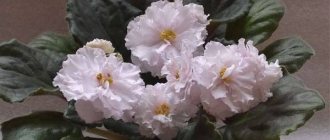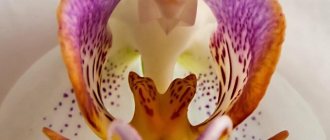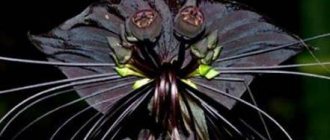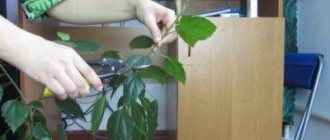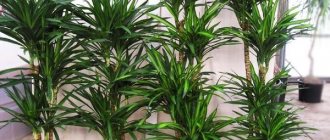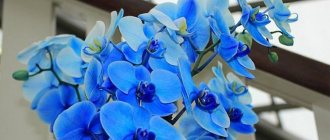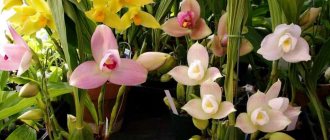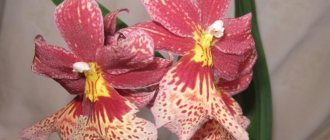| Oncidium stacyi | ||
| Scientific classification | ||
| intermediate ranks Domain: | Eukaryotes | |
| Kingdom: | Plants |
| Department: | Flowering |
| Class: | Monocots[1] |
| Superorder: | Lilianae |
| Order: | Asparagusaceae |
| Family: | Orchids |
| Subfamily: | Epidendral |
| Tribe: | Cymbidieae |
| Subtribe: | Oncidiinae |
| Genus: | Oncidium |
| View: | Oncidium stacyi |
| TPL | [www.theplantlist.org/tpl1.1/search?q=Oncidium+stacyi ???] |
K:Wikipedia:Articles without images (type: not specified)
Oncidium stacyi
(possible Russian names:
Oncidium Stacy
, or
Oncidium station
) is a perennial epiphytic herbaceous plant from the genus Oncidium - Oncidium of the Orchid family, or Orchidaceae (
Orchidaceae
).
Etymology and history of description
The species does not have an established Russian name; in Russian-language sources, the scientific name Oncidium stacyi is usually used. English name: Stacy's Oncidium.
The plant was discovered near the Bolivian city of Santa Cruz (Santa Cruz de la Sierra). Discoverer: Rene Luis Moreno. The species was described by botanist Leslie Garay, and the plant was named after his friend John Stacy. The description of the species and its commercial use caused lively controversy and scandal among specialists, which was reflected in the number of synonyms for its scientific name and played up by the writer Susan Orlean in one of her novels. Currently, Oncidium Stacy is the symbol of the Santa Cruz Orchid Club[2].
Description of the plant
One of the varieties of orchids is Oncidium. The flower is divided into a variety of species, differing in the shade of buds and leaves . If we talk about the natural habitat of oncidium, then this is almost the whole world. Some plants represent the tropics of South and Central America, others grow on mountain tops, enjoying the coolness, and still others represent savannas and semi-deserts.
Each type of oncidium has its own external features, by which the plant can be distinguished from one another. Some species resemble irises in appearance in terms of the type of flower, leaves and stem. A distinctive feature of other varieties is the roots hanging from the pot.
The leaves and peduncles of different plant species also differ from each other. As for the flowers, they all grow in the same color range : from brown to yellow and orange. The structure of the buds and their shape are very similar, and the size is almost the same.
Only after blooming do they begin to exude a delicate and pleasant aroma. Flowering occurs several times a year. The duration of this period is individual, because it will be influenced by the living conditions of the plant. If you cut a flower and place it in a vase, it can please the eye for about three weeks.
Habitat, ecological features
Bolivia, Peru.
On trees and thorny bushes. The average annual temperature is 21-24 °C. The greatest amount of precipitation falls in January - February. Seasonal temperatures in the Santa Cruz area
| Spring | Summer | Autumn | Winter |
| 18 °C - 33 °C | 22 °C - 38 °C | 20°C - 30°C | 8 °C - 29 °C |
| September 21 – December 20 | December 21 – March 20 | March 21 – June 20 | June 21 – September 20 |
Oncidium Stacey is a protected species (II Appendix CITES). The number of places where this species grows is steadily declining, as about 300,000 hectares of forests are cut down in Bolivia every year.
Oncidium care
Experienced flower growers claim that the oncidium orchid and caring for it at home are completely problem-free if you know at least the basics of growing any plant from the Orchid family.
Watering and air humidity
During the period of active growth, oncidium requires abundant watering with a little drying between successive waterings. A method often practiced by many is to immerse a pot with an orchid in a container with soft and warm (distilled or necessarily settled) water. For young oncidium plants, it is acidified to pH 5–6, passing through peat.
By autumn, watering is reduced, and for species that have a dormant period in the middle of winter, it is stopped altogether, maintaining only the appropriate high air humidity by spraying or placing vessels with water near the orchids. For plants that bloom in the cold season of the year, watering is resumed during the formation of peduncles, and after flowering their frequency decreases again.
Nutrient requirements
Oncidiums are fed from the moment new growth begins until autumn, once every 7-10 days with special fertilizers for orchids in the dose indicated on the package or reduced by half. In addition, foliar feeding is carried out monthly - the foliage and pseudobulbs are sprayed with a urea solution at the rate of 1 g per liter of water. In winter, feed once every 25–30 days, if the plant does not have a clearly defined dormant time.
Notes
- For the convention of indicating the class of monocots as a higher taxon for the group of plants described in this article, see the section “APG Systems” of the article “Monocots”.
- [www.mombu.com/orquideas/fotos-de-orquideas-y-floraciones/t-la-historia-de-la-oncidiun-stacyi-garay-20495.html History of the discovery of Oncidium stacyi
] - [www.orchidspecies.com/oncsacyi.htm Oncidium stacyi
species sketch on the Internet Orchid Species Photo Encyclopedia]
Methods for propagating oncidium indoors
Dividing the bush.
This method of propagation is applicable to adult, well-grown plants with at least 6 pseudobulbs. Division is carried out during transplantation; the soil must be completely dry before the procedure. Ondicium roots are completely freed from the substrate and carefully untangled, heavily tangled areas are cut with a knife, and the cut areas are treated with crushed charcoal or activated carbon.
When dividing, it should be taken into account that each division must have at least 3 shoots. Each young specimen is planted in its own container and immediately placed in its usual place for growth. After the division procedure, the plants are not watered for at least a week. Such young oncidiums sit in place for a very long time and have difficulty taking root.
Literature
- Icones Planetarum Tropicarum plate 572 Dodson 1982 as Oncidium wittii.
- Icones Orchidacearum Peruviarum Plate 535 Bennett & Christenson 1998.
- Orchid Species Culture: Oncidium, Bakers 2006 as Cohniella stacyi.
- The Pictoral Encyclopedia of Oncidium Zelenko 2002 as Trichocentrum stacyi.
- Ibisch, P. L. 1996. Neotropische Epiphytendiversitat - das Beispiel Bolivien. Arch. Naturwiss. Diss. 1: 1—357.
- Navarro, G. 2001. Contribución al conocimiento fitosociológico de la vegetación de epifitos vasculares del centro y sur de Bolivia. Revista Boliviana Ecol. Cons. Amb. 10: 59-79.
- Moreno A., Revista de la Sociedad Boliviana de Botánica 4(1): 131–138, Editorial FAN, 2003.
- Vásquez R., Dodson, C. H. 1983. Orchids of Bolivia. Icones Plantarum Tropicarum, plate 572.
- Navarro, G., M. Maldonado, 2.002. Geografía Eológica de Bolivia, Editorial Centro de Ecologia Simon I. Patiño, Santa Cruz 2005.
Links
- [www.orchidspecies.com/oncsacyi.htm Oncidium stacyi
species sketch on the Internet Orchid Species Photo Encyclopedia] (English) - [www.tropicos.org/name/23509131 Oncidium stacyi
at Tropicos.org. Missouri Botanical Garden.] (English) - [www.preservando.com/tstacyi-3/ Oncidium stacyi
species profile on preservando.com] - [www.mombu.com/orquideas/fotos-de-orquideas-y-floraciones/t-la-historia-de-la-oncidiun-stacyi-garay-20495.html History of the discovery of Oncidium stacyi
] - [www.flickr.com/search/?w=all&q=Oncidium+stacyi Photos of Oncidium stacyi on flickr.com] (English)
| This is a draft article on botany. You can help the project by adding to it. |
Excerpt characterizing Oncidium stacyi
The plate did not seem clean to him; he pointed to the spot and threw it. Tikhon picked it up and handed it to the barman. The little princess was not unwell; but she was so insurmountably afraid of the prince that, having heard how out of sorts he was, she decided not to go out. “I’m afraid for the child,” she said to m lle Bourienne, “God knows what can happen from fright.” In general, the little princess lived in Bald Mountains constantly under a feeling of fear and antipathy towards the old prince, which she was not aware of, because fear was so dominant that she could not feel it. There was also antipathy on the part of the prince, but it was drowned out by contempt. The princess, having settled down in the Bald Mountains, especially fell in love with m lle Bourienne, spent her days with her, asked her to spend the night with her, and often talked to her about her father-in-law and judged him. “Il nous arrive du monde, mon prince,” said M lle Bourienne, unrolling a white napkin with her pink hands. – Son excellence le prince Kouraguine avec son fils, a ce que j'ai entendu dire? [His Excellency Prince Kuragin with his son, how much did I hear?] - she said questioningly. “Hm... this boy of excellence... I assigned him to the college,” the prince said offended. “Why son, I can’t understand.” Princess Lizaveta Karlovna and Princess Marya may know; I don’t know why he’s bringing this son here. I don't need it. – And he looked at his blushing daughter. - Unwell, or what? Out of fear of the minister, as that idiot Alpatych said today. - No, mon pere. [father.] No matter how unsuccessfully M lle Bourienne found herself on the subject of conversation, she did not stop and chatted about greenhouses, about the beauty of a new blossoming flower, and the prince softened after the soup. After dinner he went to his daughter-in-law. The little princess sat at a small table and chatted with Masha, the maid. She turned pale when she saw her father-in-law. The little princess has changed a lot. She was more bad than good now. The cheeks sank, the lip rose upward, the eyes were drawn downwards. “Yes, it’s some kind of heaviness,” she answered when the prince asked what she felt. - Do you need anything? - No, merci, mon pere. [thank you, father.] - Well, okay, okay. He went out and walked to the waitress. Alpatych stood in the waiter's room with his head bowed. – Is the road blocked? - Zakidana, your Excellency; Forgive me, for God's sake, for one stupidity. The prince interrupted him and laughed his unnatural laugh. - Well, okay, okay. He extended his hand, which Alpatych kissed, and walked into the office. In the evening Prince Vasily arrived. He was met at the prespekt (that's the name of the avenue) by coachmen and waiters, who shouted and drove his carts and sleighs to the outbuilding along a road deliberately covered with snow. Prince Vasily and Anatoly were given separate rooms. Anatole sat, having taken off his doublet and resting his hands on his hips, in front of the table, at the corner of which he, smiling, fixed his beautiful large eyes intently and absent-mindedly. He looked upon his entire life as a continuous amusement that someone like that for some reason undertook to arrange for him. Now he looked at his trip to the evil old man and the rich ugly heiress in the same way. All this could have turned out, he supposed, very well and funny. Why not marry if she is very rich? It never interferes, Anatole thought. He shaved, perfumed himself with care and panache, which had become his habit, and with his innate good-natured, victorious expression, holding his handsome head high, he entered his father’s room. Two valets were busy around Prince Vasily, dressing him; he himself looked around animatedly and nodded cheerfully to his son as he entered, as if he were saying: “So, that’s exactly what I need you for!” - No, no joke, father, is she very ugly? A? – he asked, as if continuing a conversation he had had more than once during the trip. - That's enough. Nonsense! The main thing is to try to be respectful and reasonable with the old prince. “If he scolds, I’ll leave,” said Anatole. “I can’t stand these old people.” A? – Remember that everything depends on this for you. At this time, the arrival of the minister with his son was not only known in the maiden's room, but the appearance of both of them was already described in detail. Princess Marya sat alone in her room and tried in vain to overcome her inner agitation.
Errors in care, diseases and pests
When growing oncidium, it is necessary to carefully monitor the light intensity. The plant reacts very sensitively to its changes. Problems in care most often occur precisely because of a lack or excess of light.
Like many orchids, oncidium is susceptible to fungal infections in conditions of waterlogging and low temperature conditions. Brown spots on the leaves are a sign of concern about your pet's health. Against the background of obvious chlorosis, they are often a symptom of infection by a fungus of the genus Uredo, a rust causative agent imported from Cuba. It is better to cut off and destroy a leaf blade with such an enlarging spot, stop spraying and treat the plant with an antibiotic or fungicide. Putrefactive processes on pseudobulbs and foliage can also occur from keeping the orchid in a draft.
A fairly common pest in this genus is the oncidium flat mite Brevipalpus oncidii. Affected plants are treated with Actofit, Fitoverm or Vermitek, which are not too toxic for apartments, but they are ineffective at temperatures below 18 degrees, and also do not affect oviposition and larvae awaiting molting and temporarily not feeding, therefore repeated treatment is recommended, repeated every 3-4 days. within two weeks.
Among the pests of oncidium, the most common pest is the flat beetle mite, or false spider mite. It is distinguished by transverse sutures that divide the body into several parts. The oncidium is parasitized not by the usual greenhouse beetle, but by Tenuipalpus pasificus, with a pair of long thin villi on the back of the abdomen.
Much less often, scale insects, aphids and mealybugs are seen on oncidiums. Measures to combat them do not differ from the methods used for other orchids.
